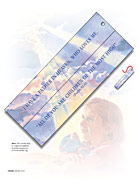“I Have a Father in Heaven, Who Loves Me,” Liahona, January 2009, F4–F5
Sharing Time
I Have a Father in Heaven, Who Loves Me
“All of you are children of the most High” (Psalm 82:6).
How can you really know that you are a child of God? Many children do not know that they have a Father in Heaven, who loves them and who can help them. Many children do not know they lived with Heavenly Father before they came to earth. They do not know they can pray to Him. Like you, they have forgotten what it was like to live in heaven.
You have scriptures, prophets, the Holy Ghost, and a family to teach and remind you what it was like to live with Heavenly Father as His child. The scriptures teach that in heaven you received your first lessons and were prepared to come to earth (see D&C 138:56). They also teach that the Holy Ghost “beareth witness with our spirit, that we are the children of God” (Romans 8:16). The songs “I Am a Child of God” and “I Lived in Heaven” (Children’s Songbook, 2–3, 4), can remind you of who you are and where you came from.
Heavenly Father wants you to remember that He is the Father of your spirit; He created you. When you say your prayers, ask Heavenly Father to help you remember that you are His child. The Holy Ghost can help you think and act as a child of God.
Activity
Cut out the bookmark on page F4, and mount it on heavier paper. Fold it in half. Glue the backs together, and punch a hole at the top. Tie ribbon or yarn through the hole. Use this bookmark in your scriptures to remind you that you have a Heavenly Father, who knows you, loves you, and will always hear and answer your prayers.

Illustration by Dilleen Marsh
I have a Father in heaven, who loves me.
“All of you are children of the most high” (Psalm 82:6)
Sharing Time Ideas
-
Using Primary 6, page 2, prepare drawings and wordstrips of the plan of salvation figures and display them in order. Begin by telling the children that Heavenly Father loves us and has given us a perfect plan. Jesus Christ is the central figure in the plan, and if we follow Him, we can return to live with our Father in Heaven. Divide the Primary into four groups, and assign each a different phase of existence. Hand out paper, pencils or crayons, scripture references, and a song or action (listed below). Have each group read their scriptures, then draw one thing that happens in that phase of the plan. When the groups are ready, teach the plan of salvation in order, using the groups to help you teach each part. Premortal life: D&C 138:56; Moses 4:2; Abraham 3:22–23 (action: raising hands and whispering, “Hurrah!”). Earth life: Abraham 3:24–25; Articles of Faith 1:3 (song: “Keep the Commandments,” Children’s Songbook, 146–47). Spirit world: Alma 40:11–14; D&C 138:30–32. Kingdoms of glory: telestial—D&C 76:81; terrestrial—D&C 76:71; celestial—D&C 76:92–96 (song: “Families Can Be Together Forever,” Children’s Songbook, 188).
-
Show a picture of a temple. Ask: “What do you think about when you see a temple or a picture of one? Why do you think people work so hard to keep the temple beautiful and clean?” Explain that a temple is a sacred, holy place.
Help the children memorize 1 Corinthians 3:16. Explain that just like the temple, our bodies are sacred and holy. We need to take good care of them. Show Gospel Art Picture Kit 114 (Daniel Refusing the King’s Meat and Wine). Tell what happened to Daniel and his friends when they treated their bodies like temples (see Daniel 1:5–20). Display objects that represent sleep, good food, exercise, cleanliness, and modesty (examples: pillow, fruit, ball, comb, necktie). Have the children pass around the objects while they sing a song about temples. Stop the music frequently, and invite the children holding an object to tell one thing they can do to treat their bodies like temples. Testify that just like the temple, our bodies are sacred and holy.